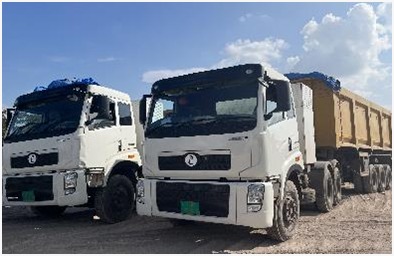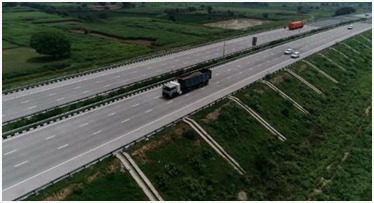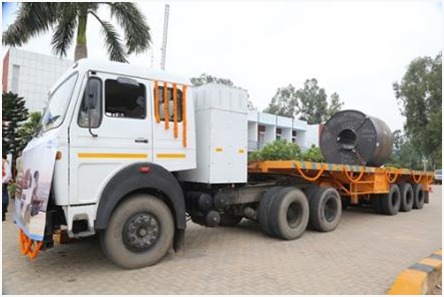ELECTRIFICATION OF TRUCKS FOR CEMENT SECTOR IN INDIA
CASE STUDIES
Case Study 1: Cement Bag Transport
Application: Transportation of cement bags from manufacturing plant to distribution hub.
Route: 45 km one way.
Number of EV Trucks Deployed: 2.
Payload: 258 kWh.
Battery Capacity: Approximately 0.6 km/kWh.
Efficiency: 6,000+ km.
Approximate Monthly Travel per EV Truck: 300 km.
Benefits/Pros Experienced:
- Operational Cost Savings: Savings of INR 20 per km.
- Improved Driver Wellbeing: Benefits from automatic transmission and mandatory charging breaks.
- Higher Depreciation Value: 40% for EV trucks compared to 30% for ICE trucks.
- Environmental Benefits: Significant reduction in greenhouse gas emissions and local pollutants.
Challenges Faced:
- Finance Cost Recovery: Requires an average running distance of 8,000 to 10,000 km per EV truck per month.
- Charging Infrastructure: The necessity for robust charging infrastructure to support long trips and high mileage.
- Reduced Payload: Compromised due to the large size and weight of the battery.
- Maintenance: There is a need for skilled maintenance personnel familiar with EV technology.
Case Study 2: Clinker Transport

Application: Transportation of clinker from a manufacturing plant (integrated unit) to grinding unit.
Route: 250+ km one way.
Number of EV Trucks Deployed: 5.
Payload: 40 metric tons.
Approximate Monthly Travel per EV Truck: 6,500 km.
Benefits/Pros Experienced:
- Lower Operation Expense: Significant reduction in operational costs compared to ICE trucks.
- Reduced CO2 Emissions: Substantial decrease in carbon emissions, contributing to environmental sustainability.
- Driver Well-Being: Improved due to less noise, vibrations, and automatic transmission features.
Challenges Faced:
- Delayed Vehicle Registration: Complications and delays in the registration process of new electric vehicles.
- Lack of Charging Infrastructure: Insufficient charging facilities along the route hinder long-distance operations.
- Longer Payback Period & Unpredictable Secondary Market: Financial returns take longer than anticipated, and the resale market for used EVs is not yet reliable.
- Fixed Route Limitations: The necessity to operate within predetermined routes due to charging station locations.
Enablers for the Initiative:
- Charging Infrastructure: Installation of charging stations at the plant and along the route.
- Adequate Remuneration for Drivers: Ensuring driver satisfaction and retention through competitive pay.
- Provision of Green Channel or Improved Turnaround Time (TAT): Streamlining operations to reduce wait times and enhance efficiency.
- Monitoring of Trips & TAT: Implementation of tracking systems to optimize logistics and turnaround times.
Case Study 3: Slag Transport

Application: Transportation of slag from the source plant to a cement manufacturing unit.
Route:40 km one way.
Number of EV Trucks Deployed: 22.
Payload: 35-40 metric tons.
Approximate Monthly Travel per EV Truck: 5,500 km.
Benefits/Pros Experienced:
- Lowest Operating Cost: A marked reduction in operating expenses compared to traditional ICE trucks.
- Lower Emissions: Significant decrease in environmental pollutants.
- High Powertrain Efficiency: The enhanced efficiency of electric powertrains contributes to better performance and fuel economy.
- Wellbeing of Drivers: Improved conditions due to quieter operations and less vibration.
- Lesser Maintenance: Reduced mechanical complexity leads to fewer maintenance requirements.
Challenges Faced:
- Limited Range & Fixed Routes: Constraints on operational flexibility due to range limitations and dependency on established charging points.
- High Maintenance Downtime & Spare Availability: Challenges in obtaining spare parts and longer downtime for maintenance.
- Additional Charging Infrastructure Costs: The financial burden of installing and maintaining additional charging stations.
- Reluctance from Service Providers: Hesitation in deploying high-value assets without assured returns.
Enablers for the Initiative:
- Long-Term Association with Service Providers: Building stable, long-term relationships with service providers to ensure reliability and service continuity.
- Battery & E-Trucks Annual Maintenance Contracts (AMC): Ensuring the longevity and performance of the fleet through comprehensive maintenance contracts.
- Dedicated Routes with Charging Infrastructure at Both Ends: Establishing dedicated routes with sufficient charging facilities to ensure efficient operations and mitigate range anxiety.
Case Study 4: Cement Bag Transport

Application: Transportation of cement bags from the grinding unit to the cement depot and return loads of slag from the steel plant.
Route: 35-40 km one way.
Number of EV Trucks Deployed: 2.
Payload: 38-40 metric tons.
Approximate Monthly Travel per EV Truck: 3,500 km.
Benefits/Pros Experienced:
- Lowest Operating Cost: Significant reduction in operational expenses compared to conventional ICE trucks.
- Lower Emissions: Considerable decrease in carbon and pollutant emissions, enhancing environmental sustainability.
- Wellbeing of Drivers: Improved due to less noise, reduced vibrations, and automatic transmission features.
- Easy Maintenance Upkeep: Simplified maintenance due to fewer mechanical components in EVs.
Challenges Faced:
- Lower Number of Trips: High detention times at depots for unloading and at the steel plant for loading reduce trip frequency.
- Battery Limitations: Restrictive battery capacity limits the feasibility of two out of three potential return routes.
- Forced Short Trips: Lack of adequate owned or third-party charging infrastructure in nearby cities confines the trucks to shorter trips.
Enablers for the Initiative:
- Green Channel at Slag Source Plant: Implementation of a green channel can significantly increase the number of trips and encourage further EV deployment.
- Owned Fleet and Driver Retention Control: Owning and effectively managing the fleet enhances control over vehicle operations and helps in retaining skilled drivers.
- Charging Infrastructure at Slag Source End: Establishing dedicated charging facilities at the slag source end to support efficient turnarounds.
Case Study 5: Clinker Transport

Application: Transportation of clinker from an integrated unit to a grinding unit.
Route: 35 km one way.
Number of EV Trucks Deployed: 5.
Payload: 40 metric tons.
Monthly Travel per EV Truck: 6,000+ km.
Benefits/Pros Experienced:
- Lower Operating Cost: A notable reduction in operational expenses compared to ICE trucks.
- Own Control Over Fleet: Enhanced operational control and flexibility due to ownership of the fleet.
- Return Loading: Efficient utilization of vehicles with return loads from the grinding unit, optimizing logistics.
Challenges Faced:
- Extended Payback Period: The payback period is approximately 4 years longer compared to ICE vehicles, due to higher initial costs.
- Secondary Market Unpredictability: Uncertainty in the resale market for electric trucks impacts long-term investment decisions.
- Short and Fixed Route: Limited route flexibility. Operational interruptions, like stock status changes and plant stoppages, significantly affect truck utilization and financial returns.
Enablers for the Initiative:
- Charging Infrastructure Installation at Both Plants: Essential to support continuous operations and minimize downtime.
- Owned Fleet and Driver Retention Control: Owning the fleet provides better management of operations and aids in retaining skilled drivers.
- Flexible Utilization of Trucks: Deploying the trucks for cement transport when clinker transportation is not required, thus maximizing vehicle usage and efficiency.
Case Study 1: Transition to Electric Vehicles in Mining Operations
A leading metals sector company in India has integrated the Normet Agitator SmartDrive EV into its underground mining operations at a world-class silver-rich zinc mine in Rajasthan, renowned for its state-of-the-art infrastructure and best-in-class mechanization. Committed to sustainable practices, the company aims to replace or convert approximately 900 diesel-run mining vehicles to battery-operated ones within the next five years, with an investment of over $1 billion earmarked for this period.
Reports indicate that the adoption of electric vehicles (EVs) will bring considerable benefits, including significant savings on high-speed diesel (HSD) and reduced vehicle maintenance costs. These SmartDrive electric vehicles are equipped with 90 kWh lithium-ion batteries and feature advanced technologies such as energy recuperation technology and hydraulic dual-circuit oil-immersed brakes, enhancing braking power and overall efficiency.
Case Study 2: Pioneering Electric Trucks in Global Mining Operations
Vale, a global mining company founded in 1942 and operating across 20 countries, has positioned itself as the first major mining company to test 100% electric 72-tonne trucks. These trials, involving vehicles from XCMG Mining Machinery Co. Ltd., were conducted at the Agua Limpa site in Minas Gerais, Brazil, and Sorowako in Indonesia. This initiative marks a significant advancement in reducing environmental impact, as these trucks emit no CO2, replacing diesel with electricity sourced from renewable energies. Additionally, they offer the benefit of reduced noise pollution, lessening the impact on nearby communities.
The vehicles, produced by XCMG Mining Machinery Co. Ltd.—a subsidiary of Xuzhou Construction Machinery Group Co. Ltd, China’s largest machinery manufacturer—are models XDR80TE. These 72-tonne electric off-highway trucks are integral to Vale’s Power Shift program. The trucks are equipped with batteries capable of storing 525 kWh, allowing them to run for up to 36 cycles or just over a day along the established routes without recharging. They feature energy regeneration capabilities during descents, which minimize mechanical brake use, reduce maintenance needs, and decrease vibration, thereby enhancing operational comfort for drivers. Additionally, these machines are equipped with temperature control technology, enabling operation under various extreme conditions such as high temperatures, humidity, and challenging weather scenarios.
Diesel-powered off-highway trucks currently account for approximately 9% of Vale’s total scope 1 and 2 emissions. The Power Shift program, initiated by Vale, aims to replace fossil fuels with clean energy sources across its operations. This program is driving innovative solutions to electrify the company’s mines and railroads, including a strategic partnership with industry peers BHP and Rio Tinto to further its operational equipment electrification strategy.
Case Study 3: Electrification of Fleet in the Nonalcoholic Beverage Sectors
A leading Indian company in the nonalcoholic beverage industry, with operations spanning 20 states, has initiated the transition to electric vehicles (EVs) by deploying three electric trucks. These trucks are currently used for inter-unit material transfers and deliveries to storage warehouses, covering a one-way lead distance of 26 km. In line with its commitment to sustainability, the company has set an ambitious goal to convert its entire fleet to electric vehicles within the next three years. Additionally, the installation of 35 EV charging stations is planned to support this transition, ensuring adequate infrastructure for efficient operations.
Case Study 4: Sustainable Transition in Steel Manufacturing

A prominent steel manufacturing organization in India has implemented electric trucks (E-Trucks) for material transport between its manufacturing plant and stockyards. The trucks cover a lead distance of 38 km and have a minimum carrying capacity of 35 tons. In a significant move towards sustainability, the organization plans to deploy a total of 27 electric vehicles, which will be shared between two manufacturing units.
The electric vehicles being introduced are equipped with a 2.2-ton 230.4 kWh lithium-ion battery pack, featuring an advanced cooling system and a battery management system. This setup enables the trucks to operate efficiently in ambient temperatures of up to 60 degrees Celsius. The battery packs are charged using a 160-kWh charging setup, capable of fully charging the battery from 0 to 100% in just 90 minutes. With zero tailpipe emissions, each electric vehicle is expected to reduce the greenhouse gas (GHG) footprint by more than 125 tCO2e annually.

